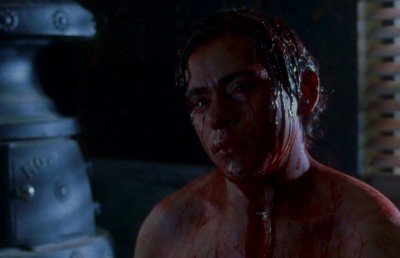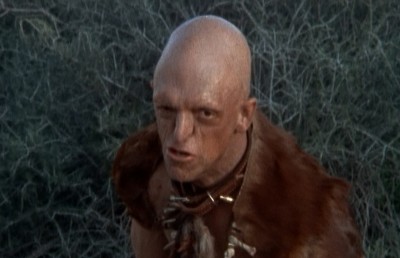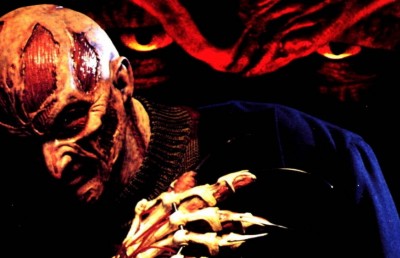Documenting the Horror Genre
Going to Pieces: The Rise and Fall of the Slasher Film Meets The Sandman
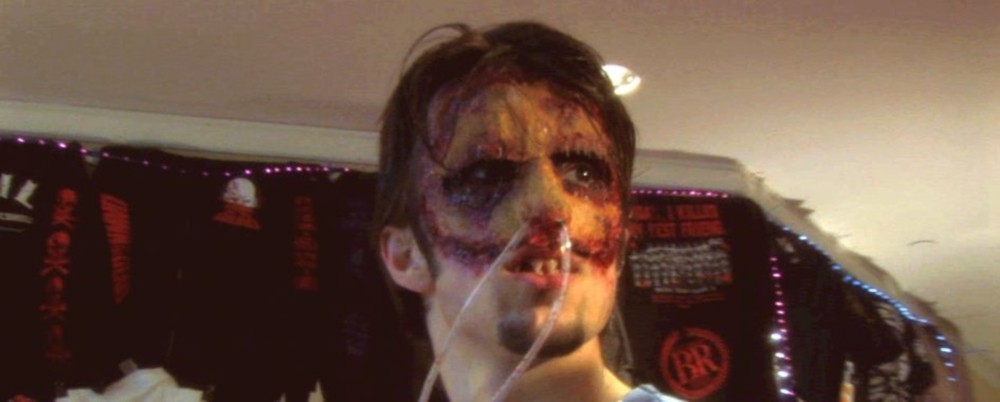
“There is a lot of darkness to the art.” Tom Savini
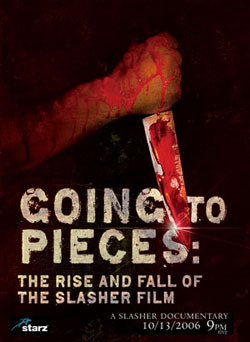
The contemporaneous appearance of two recent documentaries on the horror genre can be seen as a signpost of a paradigm shift in the evolution of a particular sub-genre of the horror film: the slasher/stalker film. The two documentaries are Going to Pieces: The Rise and Fall of the Slasher Film (dir. Jeff McQueen, 2006) and S&Man (dir. J.T. Petty, 2006). The former, based on the same titled book by Adam Rockoff (published in 2002), is the more conventional of the two, in both its content (classic slasher films from 1978 onward) and style (talking head, ‘walking’ head, clips, production history, etc.). The latter, S&Man (pronounced ‘sandman’), sets out to identify a recent outgrowth of the slasher film –the ‘hardcore’ underground horror film which features a far less sophisticated narrative in which a victim(s) is kidnapped, tortured, and usually killed– but in the process evolves into something far more complex: a commentary on the ethics of making and viewing such films; and a meta-commentary on the documentary form itself which seeks to probe and reveal ‘truth.’
Going to Pieces is head and shoulders above the first documentary made on the slasher film, Terror in the Aisles (Andrew J. Kuehn, 1984), which was a glorified montage of trailers narrated by Donald Pleasance and Nancy Allen with hardly any commentary or critical voice. Going to Pieces has more in common in terms of insight and quality with two recent documentaries on similar subjects: The American Nightmare (Adam Simon, 2002), which examines the late 1960’s and 1970’s horror films as products of the social and political unrest in post-Civil Rights America, and Midnight Movies (Stuart Samuels, 2005), which examines the (mainly) 1970’s social phenomena of the midnight cult movie.
Whenever critics and historians analyze film genres or film movements and need to identify films in question they tend to take either of two routes: the inclusive or exclusive approach. In the inclusive approach the net is cast far and wide, while in the exclusive approach only a few films which abide by a set of rigid criteria are included. For example, when it comes to the film noir, critics such as Raymond Durgnat and co-authors of the Film Noir Encyclopedia Elizabeth Ward and Alain Silver qualify a huge amount of films as film noir (over 300 in the latter book); while critics who identify film noir as a movement or period tend to select less films over a shorter historical period. Likewise with German Expressionism, where a critic like Lotte Eisner in her book The Haunted Screen discusses dozens of films made between the years 1919 and 1930; while Barry Salt in his essay “From Caligari to Who?” (Sight and Sound Vol. 48 No. 2, Spring 1979, 119-123) identifies only six films made between 1919 and 1924 as being genuinely “expressionist’ (for the record, he cites The Cabinet of Dr. Caligari 1919, Genuine, 1920, From Morn to Midnight??/ ??Von morgens bis mitternachts, 1920, Torgus, 1921, Raskolnikov, 1923, and Das Wachsfigurenkabinett??/ ??Waxworks, 1923).
The same exclusive/inclusive approach can be seen operating with the critics who analyze the slasher/stalker film. For example, one of the first film critics to take the slasher genre seriously, Vera Dika, in her essay “The Stalker Film, 1978-81,” established a core group of eleven films made between 1978 and 1981 that fit the defined formal properties she notes first established by Halloween and then slavishly followed in subsequent films. The eleven films she cites which typify the stalker film are Halloween, Friday the 13th, Prom Night, Terror Train, My Bloody Valentine, Night School, The Burning, Friday the 13th Pt. 2, Graduation Day, Happy Birthday to Me and Hell Night. 1 In Dika’s structuralist analysis, the pure stalker film is comprised of formal elements which set it apart from other films which Rockoff and director McQueen classify as slasher. For example, in the stalker film the killer’s identity is withheld until late in the film, which is not the case in a film like Maniac or Silence of the Lambs, both cited in Rockoff’s book and McQueen’s film, where the killer is identified onscreen early on and his character psychologized throughout. The stalker film also contains a two-part temporal structure, beginning with a past event where the killer is traumatized by some violent or psychosexual experience, and then moving to the present day, where an event triggers the killer’s traumatic past experience and sets him/her off on a killing spree. Hence Dika’s approach can be labeled ‘exclusive,’ in contrast to the ‘inclusive’ approach of Rockoff in his book and in the documentary Going to Pieces, which include many films that go beyond Dika’s rigid formal and narrative patterns (Maniac, Silence of the Lambs, Nightmare on Elm Street, etc.)
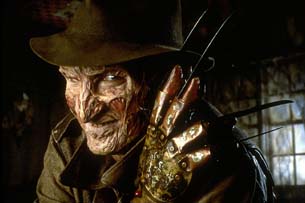
The first critic to make this distinction between the stalker and the slasher film was Steven J. Schneider, in his essay “Kevin Williamson and the Rise of the Neo-Stalker”:
The terms “slasher” and “stalker” are often used interchangeably in discussions of horror cinema, which is unfortunate considering that the former is little more than a catch-all lacking the formal and historical specificity of the latter. The position to be defended here is that the stalker is a species of which the slasher –loosely defined as a horror film in which isolated psychotic individuals (usually males) are pitted against one or more young people (usually female) whose looks, personalities, and/or promiscuities serve to trigger recollections of some past trauma in the killer’s mind– is genus. 2
Schneider then goes one further by identifying the self-conscious, reflexive post-Scream slasher films (Scream, Scream 2, I Know What You Did Last Summer, and Halloween H20) as ‘Neo-Stalkers.’ This trajectory closely describes the narrative arc of Going to Pieces which starts by looking at the seminal films (Halloween, Friday the 13th, The Prom Night), then the films of the peak early 1980’s heydays (The Prowler, Friday the 13th Part 2, He Knows You’re Alone, Terror Train, Happy Birthday to Me, The Burning, The Slumber Party Massacre, and others), the waning period (Splatter University, Curtains, Final Terror), the single film that re-ignited the slasher film, Nightmare on Elm Street (1984), the period of gentrification and corporate control of the horror icon (self-parody as seen in the Nightmare on Elm Street series, Dr. Giggles, Popcorn), the revitalized slasher film of the post-Scream period (which introduced the slasher film to a new television generation, and included two Scream sequels, Valentine, I Know What You Did Last Summer, Urban Evil), and the latest wave of films which have introduced graphic violence into the landscape of popular entertainment (House of 1000 Corpses, Hostel, Saw, The Devil’s Rejects, Wolf Creek).

Completists take note: one would be hard pressed to think of a slasher film which doesn’t make a brief appearance in Going to Pieces! And because of this Going to Pieces will be a wet dream come alive for the die hard slasher film fan. Not only are dozens of films represented, but a virtual who’s who of slasher film icons and key players in front of and behind the camera are woven into the film’s well edited pattern of interview/clip/voice-over exposition (John Carpenter, Wes Craven, Sean S. Cunningham, Paul Lynch, Armand Mastroianni, Tom Savini, Betsy Palmer, Joseph Stefano, Rob Zombie and Robert Shaye). At times it feels too much like the ‘love-in’ it is, with nary a dissenting voice. There are a few, but they are overwhelmed by the ‘voice of liberal reason.’ For example, the parental backlash against Silent Night, Deadly Night -featuring a serial killer dressed as Santa Claus– which pressured Tri-Star into pulling the film from theatres, and excerpts of Siskel and Ebert’s now famous anti-slasher film edition of “Sneak Previews” (both represented through archival footage), are rebuked through articulate (though well worn) responses by the interview subjects. Interestingly enough, most of the slasher film defense comes from women (director Amy Jones, and actresses Felissa Rose, Lilyan Chauvin and Betsy Palmer). In one fascinating turn, director turned Rabbi Herb Freed tells us that he stopped making horror films because of the violence. He quotes a Hebrew proverb: “It was good, but it’s good that it was.” And then later, during a brief segment dealing with the (usually Conservative/Republican) position which ‘blames’ the slasher film for social ills, he says, rather than worrying about horror films, “I think the world would be better without politicians who lie. I think the world would be better with avarice, without greed…”
As a point of interest with respect to the Ebert & Siskel controversy, one of their main points was that the use of continuous subjective point of view shots from the killer’s perspective placed viewers in the potentially unhealthy position of identifying with the killer: “The lust to kill and rape becomes the true subject of the movies. And the lust is not placed on the screen, where it can be attached to the killer-character; it is placed in the audience. The missing character in so many of these films can be found in the audience; we are all invited to be him, and some ….gladly accept the role.” 3 There are at least two problems with this argument: one that it is based on the assumption that the technique of continuous use of subject point of view automatically ‘invites’ a viewer to identify with the absent character. Alfred Hitchcock, no slouch in the technique department, felt quite the opposite, that a continuous use of subjective camera distances the viewer from empathizing with the character. Hitchcock felt it was necessary for the audience to see who they are supposed to identify with. Which is why he so often employed a point of view cutting style, where a pattern is established of cutting between shots where the audience sees what the character sees (subjective point of view shot) and then objective shots of the character looking. The second point relates to what Carol J. Clover has identified as the “Final Girl,” where in the classic slasher (or at least stalker) film, the audience ends up identifying with the virtuous or resourceful heroine who must defend herself against the killer. At the same time (1987) that Carol J. Clover articulated this important point of how the slasher film spectators, male and female, learn to identify with the “Final Girl” rather than the killer, Dika also noted this aspect of spectator identification in her essay “The Stalker Film, 1978-81” “…the young spectators greet the gruesome events on screen with open enthusiasm, cheering and laughing, and dividing their support primarily between the heroine and the killer.” 4
This critical interlude apart, the bias in Going to Pieces is definitely toward the practitioners of the craft, as of the many people interviewed there are only two that are not from the production side of the table: Anthony Timpone, editor of the longest running horror magazine, Fangoria (fitting enough since the magazine began almost concurrently with the slasher genre, in 1979) and Robert Oppenheimer, a former assistant editor of Advocate magazine who discusses the links between the slasher film and AIDS (the ‘faceless’ killer).
The documentary naturally takes its cue from the Rockoff book which identifies Halloween in 1978 as the beginning of the slasher film. Few people would doubt this choice as the starting point, but there have been many films with similar (though never identical) characteristics which predate Halloween. Films such as Mario Bava’s Blood and Black Lace (1964) and Twitch of the Death Nerve (1971), H.G. Lewis’ Blood Feast (1963), Bob Clarke’s Black Christmas (1974) and Tobe Hooper’s Texas Chainsaw Massacre (1974). All of these films (along with many others) are grouped together by Rockoff in a chapter entitled “The Pre-History of the Slasher Film,” which gives way to the chapter “Halloween: The Night He Came Home.” In Going to Pieces these films are pretty much ignored. The importance of Bava and Argento are treated in a ludicrously short (less than two minutes!) section entitled (surprise, surprise, “Spaghetti Slashers”), Blood Feast is (forgivably) overlooked, while (less forgivable) Black Christmas only makes a visual appearance through two brief (and untitled) clips. 5
However, while sounding critical it is clear that even with these earlier films demonstrating facets of the slasher film, it was Halloween, with its easily identifiable visual style and iconography and (most importantly) relatively huge financial success that triggered the flow of imitative, like-structured films. Of all the earlier films Black Christmas is the one that has the strongest right of stalker film parentage, having many of the same traits as Halloween: an opening which features a killer’s subjective point of view shot approaching a home and subsequent extensive use of the killer’s point of view, the holiday setting, young protagonists being murdered one by one, the withholding of the killer’s identity, and an open ending where the killer may still be at large. As a Canadian film, Black Christmas was picked up by Warner Bros. for American release, but did not do well at the box-office; as such it could not have had the immediate reciprocal influence that the hugely successful Halloween would have four years later. And if one thing is made clear in Going to Pieces, the slasher film thrived only after major studios sniffed the scent of a successful formula and began actively encouraging the production and distribution of slasher films. It can only be speculation, but perhaps if Black Christmas had done well at the box-office the stalker sub-genre would have started a few years earlier than 1978.
For those interested in more documented analysis on the stalker/slasher film, a recent television documentary series called On Screen, which devotes single hour programs to examining important Canadian films, looked at Black Christmas in its first season (it is now in its second season), interviewing many of its cast, crew, and notable film critics. The question of the film’s pedigree as the first stalker/slasher film, and its influence on John Carpenter is touched on briefly toward the end of the documentary. (Information which was previously stated by Clark in his commentary track to the 2002 Critical Mass special edition release of the DVD, which reveals that Carpenter, who had seen and admired Black Christmas, asked Clark if he was considering making a sequel to Black Christmas. When Clark replied in the negative, Carpenter asked him, rhetorically, that if he were to make a sequel what would he call it? Clark replied with the title “Halloween” and added the plot fragment of the killer being caught and institutionalized at the end of the first film, and the sequel picking up with the killer escaping and returning to the same location to continue killing. To set the record straight, the self-effacing Clark has never made much of this handed down story information, and is quick to point out that Halloween has many more differences than similarities to Black Christmas and stands as its own film.) 6
However, of more interest is learning about how Warners Bros may have sabotaged the film’s success, and in the process potentially setting back the stalker movement by a few years. According to director Bob Clark and co-producer Gerry Arbeid, Warner Bros. changed the title from Black Christmas to Silent Night Evil Night because they feared that audiences might mistake it for one of the many blaxploitation films which were being released at that time (another example of a big studio thinking very little of its audience’s intelligence). Clark and Arbeid feel the title change was partially to blame for the film’s box-office failure because it lost out on the novelty of the Christmas setting.
In some respects Going to Pieces legitimizes a sub-genre that was once denigrated and chastised as being simplistic, repetitive, and misogynist. More importantly it signals a sense of closure to the slasher film and an indication that the cycle has run its course. This does in fact seem to be the case, with the increasing popularity in recent years of ‘survivalist horror’ taking over from the ‘slasher’ film as the most popular horror sub-genre. Although Going to Pieces cites a few of these films in its concluding section (Hostel, Saw), they are included (wrongly I would argue) as an extension of the slasher film, rather than a distinct outgrowth. The narrative of many (not all) survivalist horror is even more threadbare than that of the archetypical slasher/stalker film. In a good many survivalist horror a character(s) is chased and/or kidnapped, kept hostage and tortured, with the main dynamic being whether or not the victim can escape from their assailant. Some examples of survivalist horror include: Hostel (Eli Roth, 2005, US), August Underground (Fred Vogel, 2001, US), The Dark Hours (Paul Fox, 2005, Canada), Saw (James Wan, 2004, US), Saw 2 (Darren Lynn Bousman, 2005, US), Saw 3 (Darren Lynn Bousman, 2006, US), The Descent (Neil Marshall, 2005, UK), Isolation (Billy O’Brien, 2005, Ire.), Haute Tension (Alejandre Aja, 2003, France), Wrong Turn (Rob Schmidt, 2003, US), Calvaire (Fabrice du Welz, 2004, Belgium), Wolf Creek (Greg McLean, 2005, Australia); Broken (Adam Mason, Simon Boyes, 2006, UK), Il (David Moreau, Xavier Palud, France, 2006), Wilderness (Michael J. Bassett, 2006, UK), The Last Horror Movie (Julian Richards, 2003, UK), and 39: Film by Carroll McKane (2006, Gary Sherman).
As a point for possible future development, I would like to go on record as citing the retroactive importance to this current wave of survivalist horror of a little known Canadian horror film by Montreal director Maurice Deveraux entitled Slashers, made on a shoestring budget on HD in 2001. At the film’s core are two factors behind the emergence of survivalist horror: the digital revolution and reality television. Slashers is structured as a real-time Japanese extreme reality television show in which six contestants are chased through the studio’s maze-like set by three psychotic killers, with the show’s camera objectively tracking their collective attempts to elude the three ‘in house’ killers. The single survivor wins the huge money prize. I am not saying that Slashers is the best of the survivalist horror (although iconographically it may be its most bare bones specimen), but, several years down the road, when the dust has settled on the survivalist horror sub-genre and someone makes a documentary on it (Picking up the Pieces?), Slashers will have to be reckoned with (maybe it will be the ‘survivalist’ version of Black Christmas, the second time a Canadian film gets overlooked for its ‘groundbreaking’ qualities).

This is why the S&Man documentary makes such a nice complementary companion piece to Going to Pieces: with Going to Pieces looking back at what was (stalker/slasher films) and S&Man taking stock of the current elements of the extreme, underground survivalist sub-genre. Whereas Going to Pieces spreads its wings wide, in S&Man director J.T. Petty turns his gaze at three directors who specialize in extremely low budget, shot on digital, ‘hardcore’ stalker/snuff-_like_/sexploitation/survivalist horror: Fred Vogel, who produces films under his signature label “Toe Tag Pictures,” Eric Rost, who produces films as part of the S&Man series that feel too uncomfortably close to snuff films; and Bill Zebub, who leans toward the Jess Francoesque sexploitation variety of home made product.
In some respects the underground horror boom is an echo of the 1980’s video boom, when many cheap horror films were made for the straight to video market and the popularity of the slasher film was greatly aided by the home video revolution; likewise the underground horror market is a direct result of technological factors: a) the internet for both networking and distribution and b) the relatively cheap, decent digital cameras and computer based editing programs which allow one to shoot a film, edit it on a home computer, author it onto DVD, package it, and distribute it digitally or by mail (or hosted on a server). The structure of the survivalist horror is also well suited to the low budget underground horror modus operandi: a few characters trapped in limited (usually one) locations. Also, the influence of reality TV legitimizes the cheap, amateurish visual style of these films (or at least makes them familiar).
The three filmmakers that director J.T. Petty focuses on could not be any more different from each other. Fred Vogel, who directed one of the most notorious ‘hostage’ horror films, August Underground (in 2001, which was subsequently followed up with two sequels, Mordum, 2003, and Penance, 2007) seems self-assured and well aware of the commercial dimension of his product, but still considers himself a filmmaker. Bill Zebub seems the most down to earth of the three, sporting a friendly smile and self-deprecating sense of humor (he is not trying to fool anyone into thinking he is an ‘artist’). Eric Rost is the outsider, socially awkward and usually uncomfortable in front of Petty’s camera. And yet he seems driven to use the occasion of Petty’s camera as a form of self-therapy. Rost claims that he makes films ‘on order’ of fans. He takes to the streets with his hidden camera and follows/films a potential female victim to see if she would be a good candidate. When he finds a woman/victim she is caught/tortured/killed. Each new victim becomes a new installment in the S&Man series. Rost is evasive about how he actually does this, and whether the women know they are being filmed when he is doing the ‘scouting’ (Petty cuts to sexologist Meg S. Kaplan and her husband/forensic psychiatrist Dr. Richard B. Krueger talking about paraphelia during this sequence, which makes the ambiguity more unsettling). Rost gets increasingly uncomfortable with Petty’s questioning, but also seems attracted to the attention. In a striking coincidence (which ends up perhaps not being so coincidental), Rost’s modus operandi is the actual plot of an interesting film entitled Alone With Her by Eric Nichols, 2006, in which a geeky young man first stalks a women with a hidden camera, then breaks into her house to plant several hidden cameras in her apartment, and then uses the information he learns from spying on her in her private space to ingratiate himself into her life.

The more we learn of Eric Rost, and the stickier the relationship between Petty and Rost gets, the more suspicious we become as viewers. We begin to wonder, can someone like Rost actually exist, or is he a construct of Petty to manipulate our emotions and stimulate our intellect? In the opening of the film Petty tells a story from his childhood in 1990, about a man in his neighborhood who was caught and indicted but never charged for acts of voyeurism which involved secretly filming women through house windows (they found 191 videotapes in his possession of secretly recorded voyeur footage, but when it was revealed that the tapes would have to be viewed in the courts as evidence, the charges were dropped by the community). In 2005 he sold a company, HDNet films, on the idea of making a documentary on this peeping tom and the impact it had on his own voyeurism as a filmmaker and lover of horror movies. Unfortunately, the peeping tom vehemently declined to appear in his film; however, Petty relates that “by this point I had spent more of HD’s money than I could pay back, so I needed to come up with a movie.” This last phrase is a subtle cue that the director of S&Man is in fact a fictional construct within an otherwise straight documentary.
Petty provides the voice for the beginning of his film, introducing himself with the phrase, “I make my living making scary movies, but this is going to be about scary movies.” He then moves on to his childhood story about his neighborhood voyeur, mixing reality with fiction; the snuff film with the reality of horror films which audiences are only to willing to believe. At the end of the film Petty returns to the subject which has now informed the entire being of the film: the relationship between fiction and reality, horror and snuff, documentary and mockumentary: in voice-over Petty says, “The audience that is watching a snuff movie doesn’t question its reality. But when you watch a horror movie, you want it to be real because you know it is fake [at this point Eric Rost appears on camera and introduces himself as he did at the beginning. The voice-over continues]. I imagine that the overlap between snuff and horror would be a mixture of the two: fiction inside the framework of reality, or the other way around.” Whereas the film began with Petty’s own voice, it ends with Petty’s surrogate ‘voice,’ Rost, the ‘fiction within Petty’s reality,’ as we watch the final minutes from episode 14 of S&Man. We are in a ‘killing room.’ A subjective hand held camera tracks forward to a lying female body, then tracks back and settles low to the ground (the camera probably placed on a tripod). A heavy set hooded young man –Rost– enters the frame, drags the foot-tied women to a pillar, around which is a clear plastic sheet, and ties her arms around it. The partially gagged women is screaming throughout. The man picks up the whole camera and moves it forward. There is a cut to this new camera set-up positioned closer to the woman. The man takes a knife from the kitchen drawer, calmly slits the woman’s throat and exits the frame. The shot continues for a minute or so, as she thrusts her legs back and forth against the plastic sheet until the final gasps of life leave her body. Petty gives the viewer no relief, no respite from the horror of murder. Of course it is fiction. But a fiction which could easily be taken for reality.
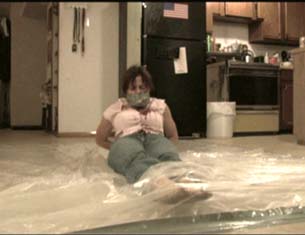
In Going to Pieces Craven tells us that he is often asked, “where do you get your ideas”? “Read the front page of the New York Times, pick any day…Now we have a war going on where people grab people and chop their heads off right in front of a video camera and then send it out to the world.” He then adds, with a bemused smile: “I actually had an interviewer ask me, ‘do you think Al Queeda got the idea of cutting off heads from watching horror movies! I said, you’ve got to be kidding!!”

The director Bill Zebub, who appears half tanked most of the time he is on camera, provides some welcome comic relief from the more intense segments with Vogel (and particularly) Rost. As Zebub tells us, “I don’t shoot movies to make art; I shoot movies so perverts will give me money.” Which begs the uncomfortable question, if perverts buy Zebub’s films, what do we call people who are interested in learning about filmmakers like Zebub? In other words, what is the outsider’s interest in this seemingly perverse underground form of violent pornography? I would have to ask the question of myself, since I found this film utterly fascinating. The presence of Professor Carol J. Clover in S&Man is of great benefit to director J.T. Petty with regards this question. As both a fan and scholar of the genre, she has the critical distance that enables her to ask the right questions about some of the more troubling or disturbing aspects of the underground horror film: why would people want to watch extreme torture and violence without the usual aesthetic distance? [And I would add, what happens when the form of aesthetic distance becomes indistinguishable from the aesthetic of reality, as the above Craven quote suggests?] How does this relate to other forms of ‘extreme’ popular culture (such as extreme sports)? Are these extreme underground horror films where there is no plot to speak of a ‘gorenography’? And what do we mean by this: that the structure is like pornography or that people get ‘off’ on them? These are the sort of uncomfortable questions posed in S&Man which are (no doubt consciously so) left out of Going to Pieces and another reason why the two films complement each other so well.
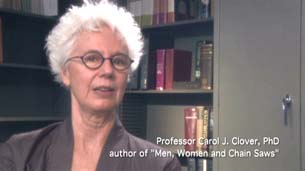
To my welcome relief (at least I would like to hope so!), my fascination with S&Man had more to do with director Petty’s intoxicating blend of distanced analysis (interviews with ‘authorities’, filmmakers, actresses, contextualization of these films with other more respectable forms of the genus, Peeping Tom, Psycho, Henry: Portrait of a Serial Killer, etc.) with the increasingly queasy relationship between him and the most interesting of the three filmmakers (admittedly from a strictly voyeuristic point of view), Eric Rost, a character so fascinating that if he did not exist someone would have had to invent him. And that someone was J.T. Petty.
Notes
- Vera Dika. “The Stalker Film, 1978-81.” Gregory A. Waller, ed. American Horrors.” Urbana and Chicago: University of Illinois Pres, 1987, p. 86-101. Dika also published a book on the stalker film in 1990, Games of Terror: Halloween, Friday the 13th, and the films of the stalker cycle. ↩
- Steven Jay Schneider, “Kevin Williamson and the Rise of the Neo-Stalker.” Post Script: Essays in Film and the Humanities Vol. 19.2 (2000): pp 73-87. ↩
- Roger Ebert. “Why Movie Audiences Aren’t Safe Any More.”; American Film (March 1981): 54-56, quote p. 56. ↩
- Dika wrote her essay “The Stalker Film, 1978-81” in 1987, the same year that Clover wrote the essay which would later form the backbone of her seminal book Men, Women and Chainsaws: Her Body, Himself: Gender in the Slasher Film.” Representations 20 (1987). ↩
- To Adam Rockoff’s credit, Bava, Argento, and H.G. Lewis are given more coverage in his book, and the extent of Rockoff’s involvement with the film is unclear to me. ↩
- If imitation is the sincerest form of flattery, then it should be noted that Black Christmas has just been remade by Glen Morgan (2006). ↩



